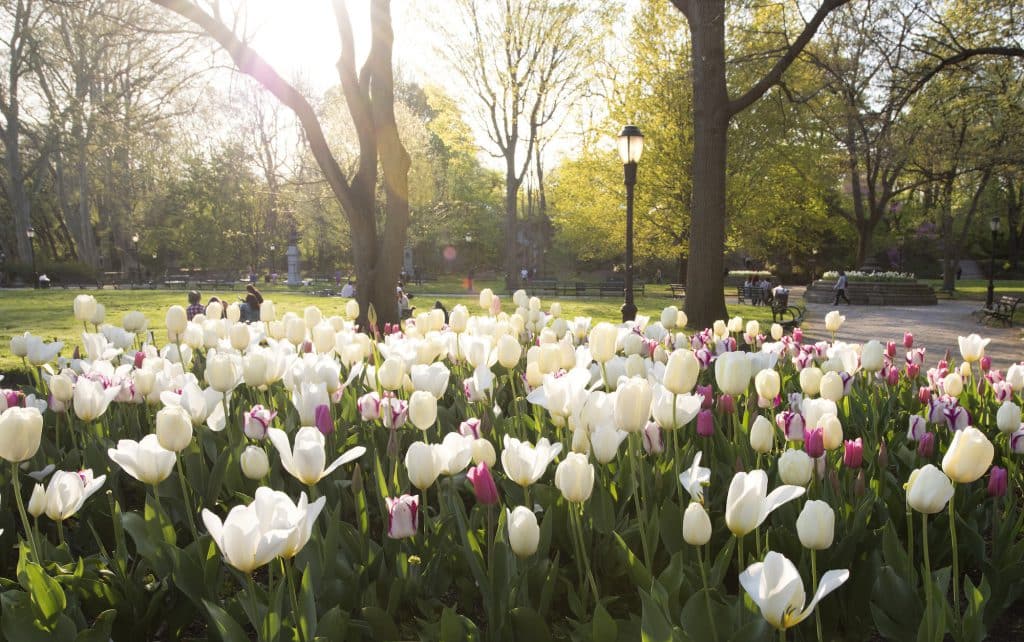Prospect Park 150: The Connective Project On View July 7-17
July 6, 2017
Prospect Park Alliance, AREA4 and Architect Suchi Reddy Present 150th Anniversary Public Art Installation Bringing Together Diverse Communities that Love Prospect Park
Prospect Park Alliance, AREA4 and Suchi Reddy of Reddymade Architecture & Design debut a large-scale public art installation in Prospect Park on the occasion of the Park’s 150th Anniversary.
On view July 7-17 2017, The Connective Project transforms Prospect Park’s Rose Garden—a little-known landscape in the Park’s northeast corner—into an immersive, engaging and ever-growing display. The installation features artwork, photographs, verse and prose submitted by emerging artists, notable Brooklynites and the diverse communities that consider the Park “Brooklyn’s Backyard.” During the installation, the public will be invited to take part in making additional pinwheels to add to the display during select hours.
“Prospect Park Alliance is thrilled to be working with the team at AREA4 and Suchi Reddy on this whimsical and dynamic public installation,” said Sue Donoghue, president of Prospect Park Alliance. “When we set out to plan our major events celebrating the Park’s 150th, our key goal was the engage the community in the celebration, which The Connective Project achieves in a beautiful and innovative way.”
Background on the Connective Project
The Connective Project is composed of more than 7,000 individually designed pinwheels, printed with work submitted by the public. The installation creates an evolving, undulating wave of color and beauty that blankets the two-and-half acre plot, which is the focus of future restoration by the Alliance. Reddy chose pinwheels because they are universally loved objects of childhood memories, much like public parks, and evoke nature in their movement attuned to wind and natural forces.
“Our inspiration behind the Connective Project was to bring together the broader Brooklyn community with the Park in a unique way at the level the 150th anniversary deserves,” said Rory McEvoy, president of AREA4. “This is an elegant and inclusive way for people to add their unique voice to a collective undertaking: a reflection of the Park’s usage and the Alliance’s care of it.”
The installation was conceived as an architectural form that would immerse and engage the community,” said Reddy, who has long been an advocate of architecture for the people. “Architecture is accessible and tangible and easily translatable. We wanted to create something that would initiate a dialogue about the importance of public spaces, which we feel is so important right now, but also something that generates wonder and play.”
Reddy’s vision was very much influenced by the beauty and vision of Prospect Park’s designers Frederick Law Olmsted and Calvert Vaux, who in 1867 transformed 585 acres of rural terrain into the urban retreat that is Brooklyn’s Backyard. Now 150 years later, the Rose Garden will be experienced again in grand fashion, full of color and whimsy, a nod to the creative spirit that pervades Brooklyn and Reddy’s practice.
The pinwheels are constructed of weather-resistant, compostable paper made from stone dust. The community engagement process began with an open call to artists to submit works for a chance to be selected by a panel, consisting of representatives from the Brooklyn Council of the Arts, the Brooklyn Museum, BRIC Arts & Media, PIONEER WORKS, MoCADA, and Russell Simmons’ Rush Philanthropic Arts Foundation.
Artist Ansel Oommen was selected as the winner of the open call. Prints of his piece, Chitin & Furanocoumarin, will be on sale in the Brooklyn Museum gift shop during the installation, along with works by the top ten finalists. Pioneer Works will be featuring the winning artist’s work as well as displaying the pinwheels of the top ten finalists and 20 runners up as part of their Second Sundays event taking place on August 13th. This event will also feature pinwheel making in the Pioneer Works’ garden.
The Connective Project is funded in part by Bloomberg Philanthropies, with additional support from NewYork-Presbyterian Brooklyn Methodist Hospital and GSB Digital.

